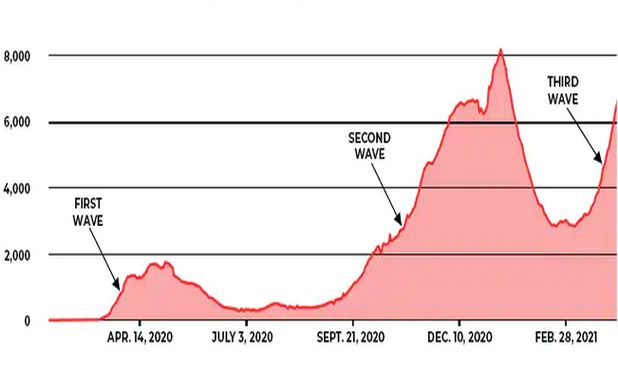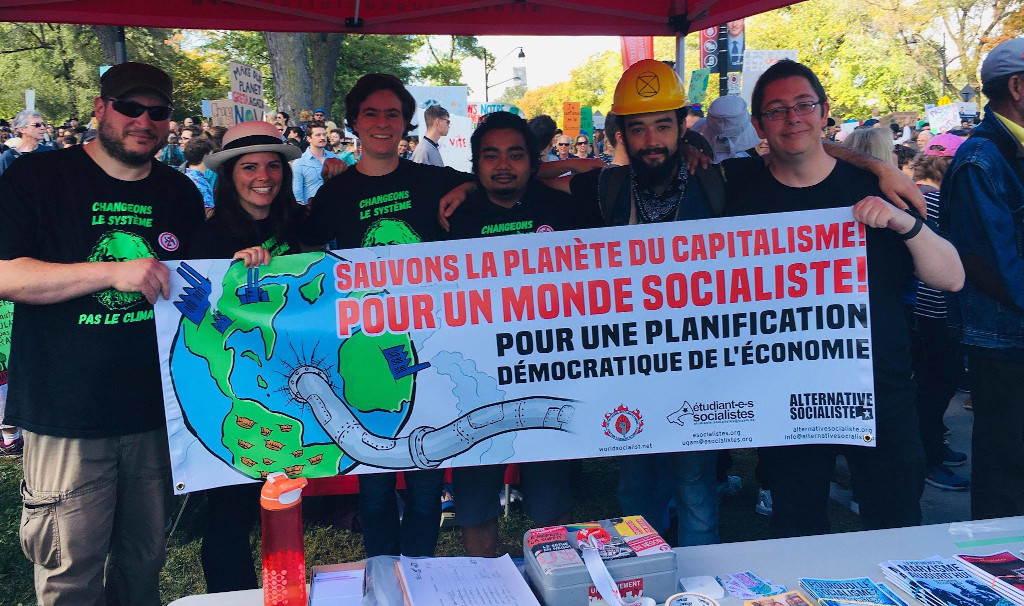The third COVID wave is crashing over most of Canada, and much of the rest of the world. Governments are blaming new variants of the virus, but the problem lies deeper than the variants. To be hit by three waves is a failure of governments.
In Britain in the autumn of 2020, the new variant, B117, was found to be up to 70 percent more infectious and more deadly, killing 50,000 people in three months. The variant that emerged in Brazil, P1, is up to 250 percent as infectious and more deadly. The Canadian and provincial governments had strong warnings at the end of 2020 to act to stop the new variants causing a new deadly wave. Yet little was done, restrictions were eased as cases of the variants climbed. Even now, as cases are soaring in several provinces it is – again – too little, too late. It may take months to again get the pandemic under control. Then will provinces act to eradicate COVID or yet again allow it to come back?
With a few exceptions most governments have never tried to eradicate the virus, limiting their goal to keeping infections low enough to not overwhelm the hospitals. The policy is like getting rid of half the mice infesting a home and then stopping – the mice will rapidly reproduce to the old numbers. This halfway policy has resulted in a deadly and demoralizing cycle of imposing restrictions, then loosening them, followed by further round of restrictions. Repeat. Insanity is defined as “doing the same thing over and over again but expecting different results.”
Canada on April 3, 2021, had 610 COVID deaths per million people. Some countries that aimed to control the virus have much lower death rates: Taiwan 0.4 deaths per million people, Australia 35.6, New Zealand 5.4, Vietnam 0.4, Cuba 38 and Mongolia 3. Atlantic Canada and the northern territories have taken a similar approach, with much lower rates of death than the rest of Canada.
Canada was slow to respond in March 2020, but once governments acted, the public overwhelmingly supported and carried out the policy actions. Most governments enjoyed a boost in public approval. There was a feeling of “we are all in this together.” Essential workers were applauded and some businesses, bowing to public pressure, boosted pay.
With a lot of sacrifice from workers, by the end of June new cases had dropped to under 300. But, instead of driving the cases down toward zero, the federal and provincial governments relaxed. By the end of August cases were inexorably climbing to a new peak finally reached in January.
This repeated pattern of on-off restrictions is deadly, exhausting, undermines trust and is damaging to health and employment. It is irresponsibly playing with people’s lives. The key ways of dealing with pandemics have been known for centuries. Central to success is public health policy: restrict movement of people and gatherings, wear masks, keep six feet apart, disinfection and isolate cases. In 16th century Italy, medical treatment and food was provided free of charge to the poor.
Few of these were thoroughly enacted in most of Canada. The border controls in Canada were always weak and mainly applied to drivers at the US border and most non-Canadian residents flying into Canada. CEOs flew to Canada without any restraints. Even when the new, more infectious, variants appeared, little was done as is demonstrated by the speed that they have spread across the country.
In almost every way, the last year has shown that we are not in this together. There is one law for the rich, one for the poor. The rich have got richer during COVID, working people have struggled.
Over the last year, the basics of protective equipment, rigorous testing systems, tracing of cases and borders controls have all been weak. At no stage has the government commandeered factories and laboratories to make PPE and test equipment, and carry out tests. The homeless have been left on the streets while hotels stand empty, and the staff laid off. Instead, in Canada, the main focus has been on waiting for the vaccines.
Why have public health actions been weak with the policy focused on waiting for a vaccine? Maybe because there is a lot of profit in vaccines and not so much in public health. But the super-profits, for the private shareholders, only come if the public sector gives large subsidies to Big Pharma, who are famously risk averse to investing in vaccine research. Pfizer and Moderna are now household names, surrounded by the glow of sainthood. Yet all the basic research for their vaccines was done at the US’s National Institute of Health and other publicly funded laboratories. The US government poured $10.5 billion into developing the vaccines in the last year.
Initially, Big Pharma was not interested in vaccine development. Zain Rizvi, of Public Citizen, told the Financial Times that the “immense scarcity” of vaccines was directly attributable to Big Pharma being “missing in action” as COVID took off. Years ago, the drug companies had cut back on vaccine research and development in favour of blockbuster drugs to treat cancer and rare diseases, though the likelihood of a pandemic had long been pointed out.
The epidemics of SARS in 2003 and MERS in 2008, both in the same family as COVID, were warnings. Vaccines for these were not developed as Big Pharma assessed the market to be too small. If vaccines had been developed then, there would have been a vaccine that, from the beginning, could have worked in at least 30 to 40 percent of COVID cases. Even after the World Health Organization declared COVID a pandemic on March 11, 2020, three of the largest corporations, GSK, Sanofi and Merck, that dominated the vaccine market, were reluctant to get involved. They calculated that the pandemic would have run its course before a vaccine was ready. Another demonstration of public health being sacrificed on the altar of profits.
The BBC reported in December 2020 that, “Initially firms didn’t rush in to fund vaccine projects. Creating vaccines, especially in the teeth of an acute health emergency, hasn’t proved very profitable in the past. The discovery process takes time and is far from certain. Poorer nations need large supplies but can’t afford high prices. And vaccines usually need to be administered just once or twice. Medications that are wanted in wealthier countries, especially ones that require daily doses, are bigger money-spinners.” It was only after the governments of the European Union, UK and US and agencies offered funding, including the main cost of running the Phase 3 trials, assuming most of the risk in the process, that the industry started work on vaccine development, making rapid progress.
As disgraceful as the failures in health, such as protecting seniors and strong tracking and tracing, is the policy of blaming by governments of anyone but themselves, especially low paid young people, women and racialized groups doing essential work to keep society running.
There has been a steady flow of racist blame. Doug Ford dog whistled about “large weddings” and Kenney, “big family gatherings at home.” Both comments were aimed at the South Asian community, many of whom, as Calgary councillor Chahal pointed out, are working-class people working in trucking, distribution, warehouses, grocery stores and nursing homes. “They’re working on the front lines. They don’t have a choice to work from home. There’s high rates of public transit use in northeast Calgary, even during the pandemic.”
Doug Ford blamed care home workers for the deaths there. These workers are low paid, mostly women and often recent immigrants who risk illness; over a thousand have had COVID and several have died.
Young people have come under constant attack with BC’s NDP Premier Horgan levelling the latest, telling people between 20 and 29, “do not blow this for the rest of us.”
It is easy for people in big houses and cars who work from home and never ride transit to attack the people who live in small apartments or shared accommodation, ride transit and do essential work. Easy but disgusting.
This is especially galling as the authorities know which are the big spreading locations and consistently do nothing about it.
Information from Ontario and Québec show that between 85 and 90 percent of infections are contracted in three areas: work, education, and health and care homes. Listening to the governments and public health officers, no one would know this. They never berate the owners of large workplaces; they insist on keeping schools open as much as possible and have done little to protect people in care.
The worst workplaces are the large ones, such as warehouses, food plants and factories. Toronto Public Health records show that 68 percent of workplace outbreaks take place in food processing plants, offices, warehouses, shipping and distribution centres and construction sites, while only 9 percent started in bars, restaurants and nightclubs and 10 percent in retail. Yet public health officers are slow to act, if at all, being very reluctant to close them down. Amazon in Brampton had 600 cases before it was closed. Meat plants in Alberta are repeat offenders, but public health does not act. Small businesses such as restaurants, bars and small stores are regularly closed. Big box retail is hardly touched. It may be a public health emergency, but the profits of big business are not to be touched.
BC is diverting 68,000 vaccines from front line workers to food processing plants, agricultural operations with congregate accommodations, large industrial camps with congregate accommodations, and other large congregate-living settings for workers. This is an admission that the province never made these places safe through reduced capacity (as restaurants had to do) and providing workers with single bedrooms. If the employers refused to make them safe, close them down and force them to pay the workers’ wages. Finally, on April 8, with the highest number of new cases in BC since the start of the pandemic, the government has announced it will close workplaces with three or more cases – although schools are excluded.
Across Canada the failure to provide sick pay adds to COVID woes. The workers most in need of sick pay are the low paid, essential workers in warehouses, care homes, grocery stores, yet they have no sick pay. Governments refuse to act. Blaming others for their failures is cheaper.
This cat and mouse dicing with death has exhausted health workers as they face a third rising wave. Educators in schools are near burnout. Transit, grocery store and delivery workers are all worn down. The public is weary of restrictions, doubting governments and fed up.
Public trust and cohesion are essential to fighting pandemics. The governments of Canada and the six big provinces have squandered that trust and damaged cohesion.
COVID has starkly revealed the inequality and injustice of society. Governments in most of Canada have failed for over a year to act decisively to stop COVID, claiming they had to balance health and the economy. Instead, they have damaged both. The failure over COVID has killed 23,000 people and counting, inflicted huge emotional and mental stress, and caused probably half a million other health procedures to be delayed. Employment has not returned to pre-COVID levels, government debt has ballooned, and many small businesses have closed or are on life support. Of course, big business is mostly doing fine, the stock market is soaring, corporate takeovers are booming. The rich have money to spend. The real interest governments have defended are the super-rich and big corporations, not the everyday economy that sustains most of us.
Behind COVID an even great disaster looms for humanity – climate catastrophe. Governments mostly failed to deal with a pandemic, which isn’t that hard as a few countries have demonstrated. Tackling the ecological disasters require international planning and cooperation, actions beyond the imagination or action of capitalism and its governments.
COVID and Climate Change are two good reasons to get rid of capitalism. Canada and humanity needs a socialist revolution. If interested, join Socialist Alternative.




